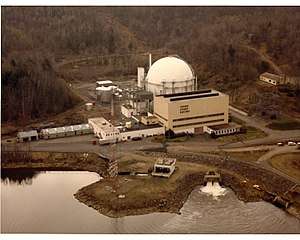Yankee Rowe Nuclear Power Station
Yankee Rowe Nuclear Power Station (decommissioned) was a nuclear power plant in Rowe, Massachusetts, that operated from 1960 to 1992. The 185-megawatt electric pressurized-water plant, located on the Deerfield River in the town of Rowe in western Massachusetts, right on the border of Readsboro, Vermont, permanently shut down on February 26, 1992, after more than 31 years of producing electricity for New England electric consumers.

Most of the men and women who worked either in the plant or during the decommissioning efforts referred to the site as "Yankee-Rowe" or simply "Rowe", to avoid confusion with Vermont Yankee, another nuclear power station located in nearby Vernon, Vermont.
Firsts
First power plant in this area was W.T. Turner's Hydro-electric production service to the town of Charlemont. Yankee atomic is the distant second as far as local heritage and historical significance. Yankee Nuclear Power Station (YNPS) was the third commercial nuclear power plant built in the United States and the first built in New England.[1] According to several sources Yankee Rowe was the first commercial pressurized water reactor operating in the United States.[2][3] This view discounts the government-sponsored Shippingport Atomic Power Station, which was not built on a commercial basis and relied on several technologies that would not be embraced by the commercial operators.[3][4] The Dresden Generating Station, a commercial boiling water reactor (BWR), slightly preceded the opening of Yankee Rowe in 1960.[3][5][6] US government sources place the first self-sustaining nuclear reaction at Dresden-1 on 15 October 1959 and the first one at Yankee Rowe on 19 August 1960.[7] Yankee Rowe began commercial operation in 1961.[8]
It has also been named as the first large-scale nuclear unit in the United States.[9]
Construction
Yankee Atomic Electric Company (YAEC) was incorporated in Massachusetts in 1954. YAEC was sponsored by ten New England utilities for the purpose of constructing and operating New England's first nuclear power plant, the Yankee Nuclear Power Station. Owners and ownership percentage:
- New England Power Company 34.5%
- Connecticut Light and Power Company 24.5%
- Boston Edison Company 9.5%
- Central Maine Power Company 9.5%
- Public Service Company of New Hampshire 7.0%
- Western Massachusetts Electric Company 7.0%
- Central Vermont Public Service Corporation 3.5%
- Commonwealth Electric Company 2.5%
- Cambridge Electric Light Company 2.0%
Construction of the plant was completed in 1960 at a cost of $39 million. The capital cost was $45 million against an estimated cost of $57 million, according to the engineering consultant Kenneth Nichols, who had been deputy to Leslie Groves on the Manhattan Project. He wrote that the Connecticut Yankee and Yankee Rowe nuclear power plants were considered "experimental" and were not expected to be competitive with coal and oil, they "became competitive because of inflation ... and the large increase in price of coal and oil." When the Yankee Rowe plant was announced Admiral Hyman Rickover called him and said the "low cost figure" of $57 million was "impossible to achieve … and I hate to see you ruin your reputation." But Nichols replied that many items were on fixed prices and many of the conventional components would be to normal utility standards to save money without sacrificing safety or reliability.[10]
During its 32-year operating history, the Yankee plant generated over 34 billion kilowatt-hours of electricity, and had a lifetime capacity factor of 74%.
Decommissioning
Yankee Rowe was shut down prematurely due to reactor pressure vessel embrittlement concerns.[9] This safety factor is now scrutinized in all plants (see ductility). In 2007, the Nuclear Regulatory Commission declared the decommissioning of Yankee Rowe complete.[11] In total, the cost for decommissioning the plant was $508 million, up from an initial estimate of $368 million.[12]
While most of the grounds were released as safe, a cask storage facility remained under NRC supervision. 533 spent fuel assemblies weighing approximately 800 lb (360 kg) each are still on-site. They are contained in dry casks made of 21 inches of reinforced concrete, surrounding a 3-1/2 inch thick steel liner, with each cask weighing 100 tons. The sixteen casks sit on a 3-foot thick concrete pad. These will be located at the site until the U.S. Department of Energy completes a permanent storage facility for spent nuclear reactor fuel and the spent fuel stored at Rowe can be transferred to such a future federal facility. The time frame for removal of spent fuel from the Yankee Rowe site is unknown.
References
- "Yankee Nuclear Power Plant". www.yankeerowe.com. Retrieved 2019-03-17.
- Yoshiaki Oka (2014). Nuclear Reactor Design. Springer. p. 128. ISBN 978-4-431-54898-0.
- Hore-Lacy, Ian (2010). Nuclear Energy in the 21st Century: World Nuclear University Press. Academic Press. p. 149. ISBN 978-0-08-049753-2.
- C.W. Forsberg, K. Takase and N. Nakatsuka (2011). "Water Reactor". In Xing L. Yan, Ryutaro Hino (ed.). Nuclear Hydrogen Production Handbook. CRC Press. p. 192. ISBN 978-1-4398-1084-2.CS1 maint: uses authors parameter (link)
- Kingery, Thomas B. (2011). Nuclear Energy Encyclopedia: Science, Technology, and Applications. John Wiley & Sons. p. 274. ISBN 978-1-118-04348-6.
- Bodansky, David (2007). Nuclear Energy: Principles, Practices, and Prospects. Springer Science & Business Media. p. 33. ISBN 978-0-387-26931-3.
- https://web.archive.org/web/20120222154328/http://www.nuclear.gov/pdfFiles/History.pdf
- http://www.yankeerowe.com/info.html
- Oldest operating US nuclear power plant shut down
- Nichols, Kenneth David. The Road to Trinity: A Personal Account of How America's Nuclear Policies Were Made. New York: William Morrow and Company. pp. 342–344. ISBN 0-688-06910-X. OCLC 15223648.
- Harrison, Tom (December 24, 2007). "Decommissioning activities completed at 11 sites in FY-07". Inside N.R.C.
- Nicola Armaroli, Vincenzo Balzani: Energy for a Sustainable World – From the Oil Age to a Sun-Powered Future. Wiley-VCH 2011, p. 142-144.